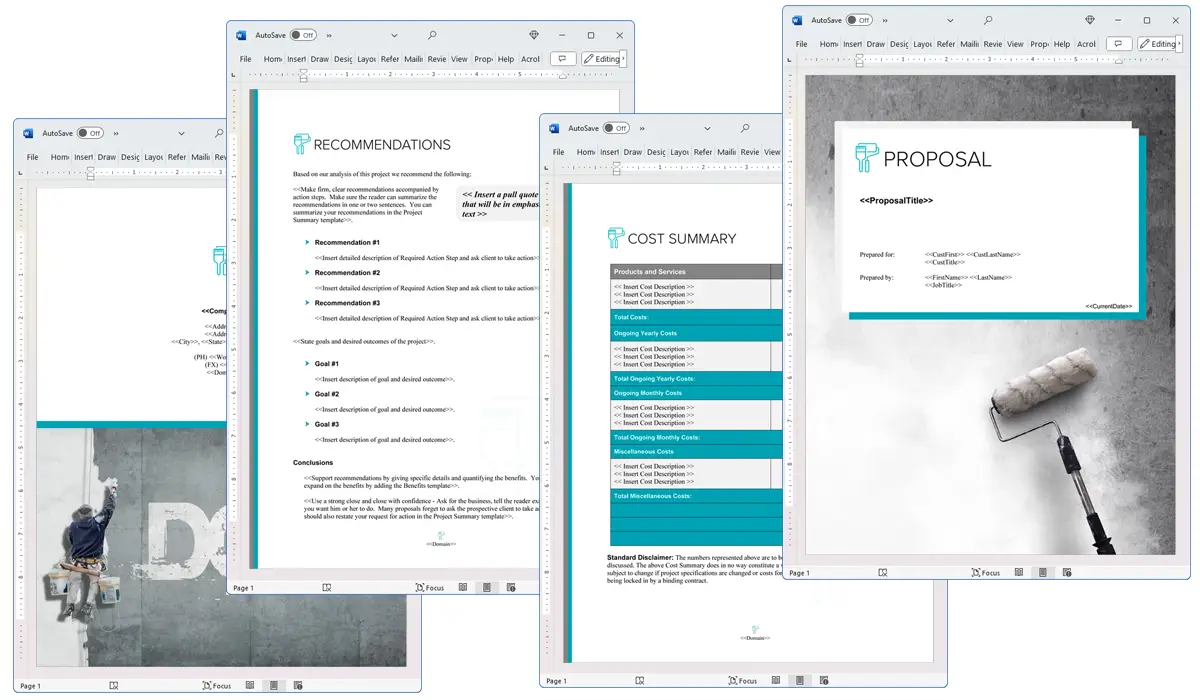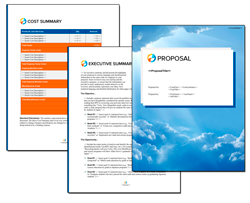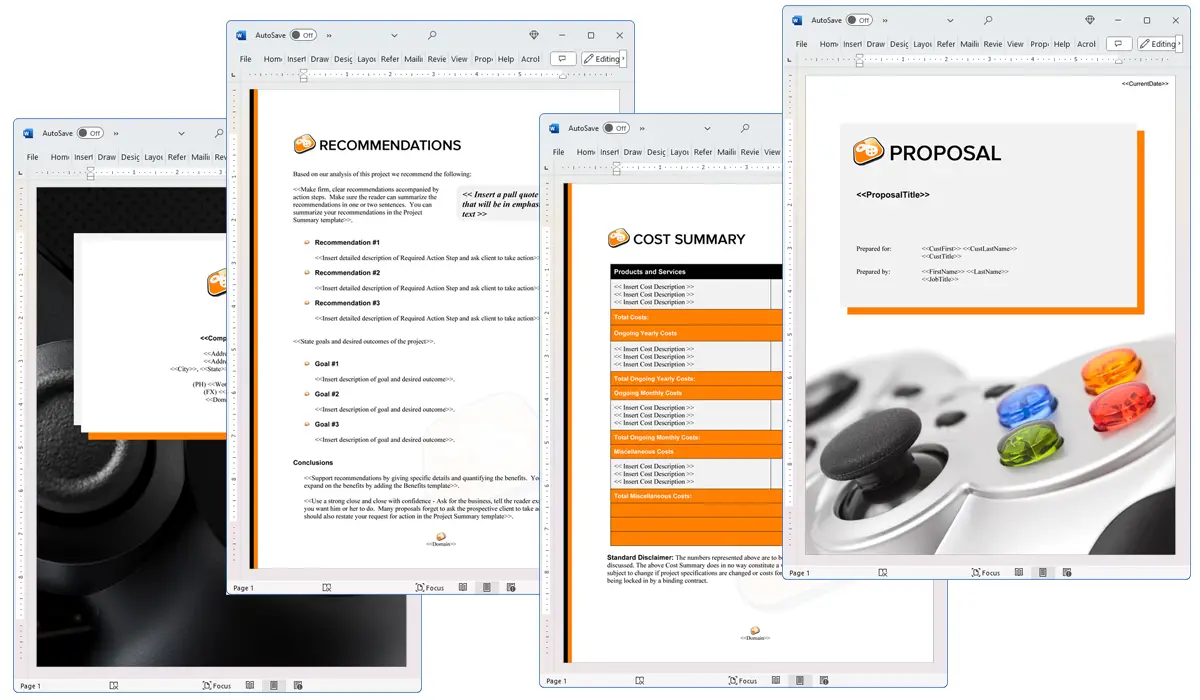What is the Code of Conduct chapter used for?
Proposal Kit Professional Bundle adds more design themes, all six Contract Packs,
a project management library, and Expert Edition software.

Illustration of Proposal Pack Painter #4
We include this Code of Conduct chapter template in every Proposal Pack, along with thousands more. You assemble this chapter with others in various combinations to create custom-tailored business proposals, plans, reports, and other documents. Proposal Packs apply custom visual designs to the templates, giving the final documents a consistent professional finish.
 DOWNLOADABLE, ONE-TIME COST, NO SUBSCRIPTION FEES
DOWNLOADABLE, ONE-TIME COST, NO SUBSCRIPTION FEES
Overview of the Code of Conduct Chapter
The Code of Conduct chapter is an important component in the structure of a business proposal document when outlining expected behavioral standards. This chapter serves as a declaration of the values and ethical benchmarks a company upholds and expects from its workforce, whether they are employees or volunteers. By incorporating this chapter into a proposal, businesses clearly communicate the importance they place on integrity and professionalism, which can significantly influence the decision-making process of potential clients or partners.
How is the Code of Conduct Chapter Used?
In a business proposal, the Code of Conduct chapter is used to set forth the rules and expectations that govern the behavior of individuals within the organization. This is particularly vital when businesses seek to establish new partnerships or when the conduct of personnel can directly impact business outcomes. By articulating these standards clearly, companies not only assure partners of their commitment to ethical practices but also lay the groundwork for internal accountability and quality control.
What is Included in the Code of Conduct Chapter?
This chapter typically includes several key elements:
- Dress Code: Specifies the attire expected of employees or volunteers to maintain a professional image.
- Behavioral Guidelines: Outlines how individuals should interact with clients and colleagues, including specific phrases to use or actions to take during interactions.
- Ethical Standards: Details the ethical lines that should not be crossed, which might include issues like confidentiality, honesty, and fairness.
- Disciplinary Actions: Explains the consequences of violating the code, providing clarity on how such situations are handled.
- External Conduct: Sometimes, guidelines on how employees should conduct themselves outside of work are also included, emphasizing behaviors that could reflect on the company's image.
Use Case Examples for the Code of Conduct Chapter
- Service Industries: Ensuring that all employees greet clients with a uniform, friendly greeting to build trust and consistency in customer service.
- Retail Businesses: Requiring cashiers to follow specific procedures during check-out to enhance security and customer interaction.
- Corporate Sectors: Implementing a dress code that aligns with the professional standards expected in corporate environments.
- Non-profits: Guiding volunteers on how to handle sensitive information about donors or beneficiaries responsibly.
- Manufacturing Units: Stipulating safety protocols and ethical guidelines that workers must follow to maintain a safe and fair working environment.
Key Takeaways
- The Code of Conduct chapter is important for conveying the ethical standards and behavioral expectations of an organization.
- It serves to assure potential clients and partners of the company's commitment to integrity and professionalism.
- This chapter typically covers dress codes, interaction guidelines, ethical norms, disciplinary measures, and sometimes external behavior.
- It is especially relevant in industries where employee conduct directly affects customer perceptions and company reputation.
- Clearly outlined conduct guidelines help in maintaining consistency and accountability within the organization.

Illustration of Proposal Pack Elegant #6
 What Our Clients Say
What Our Clients SayYou just can’t find an easier way to put together a proposal than by using the Proposal Pack Wizard. I’ve used other products before but all they did was present me with a bunch of documents, half of which I did not need in my proposals. These other products actually made the job harder, not easier. Ever since purchasing the Proposal Pack Wizard I’ve actually been able to respond to Request for Proposals faster than ever before. This has allowed me to submit more proposals which, in turn, has given me more opportunities to increase my revenue."
 4.7 stars, based on 849 reviews
4.7 stars, based on 849 reviewsRelated Chapters
Document Layouts Using the Code of Conduct Chapter
- Awareness and Sensitivity Training in the Workplace Proposal
- Business Governance Plan
- Collections Agency Services Proposal
- EMS Training Services Proposal
- Racial Diversity Training and Awareness Proposal
- Human Resources Strategic Planning Proposal
- Outsourcing Telemarketing Proposal
- Crisis Resolution Training Proposal

The Code of Conduct chapter and other chapters are integrated into a Word document as illustrated here in the Proposal Pack Computers #7 design theme. There are hundreds of design themes available, and every design theme includes the Code of Conduct chapter template.
A proper business proposal will include multiple chapters. This chapter is just one of many you can build into your proposal. We include the complete fill-in-the-blank template in our Proposal Pack template collections. We also include a library of sample proposals illustrating how companies in different industries, both large and small, have written proposals using our Proposal Packs. This template will show you how to write the Code of Conduct.
We include a chapter library for you to build from based on your needs. All proposals are different and have different needs and goals. Pick the chapters from our collection and organize them as needed for your proposal.
Using the Proposal Pack template library, you can create any business proposal, report, study, plan, or document.
The Wizard software includes an AI Writer, which will write the content of this and any other chapter of your document. Use the AI Writer to do the heavy lifting, writing the first draft of your proposal or business document in minutes.
 Ian Lauder has been helping businesses write their proposals and contracts for two decades. Ian is the owner and founder of Proposal Kit, one of the original sources of business proposal and contract software products started in 1997.
Ian Lauder has been helping businesses write their proposals and contracts for two decades. Ian is the owner and founder of Proposal Kit, one of the original sources of business proposal and contract software products started in 1997.By Ian Lauder
 Published by Proposal Kit, Inc.
Published by Proposal Kit, Inc.


 Cart
Cart
 Facebook
Facebook YouTube
YouTube Bluesky
Bluesky Search Site
Search Site